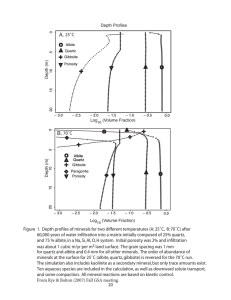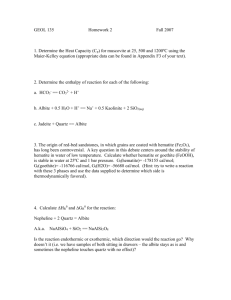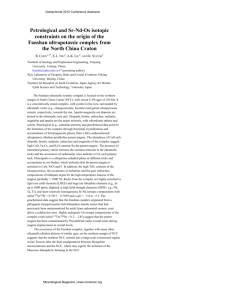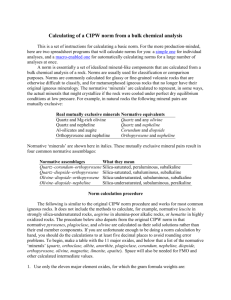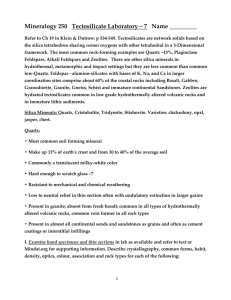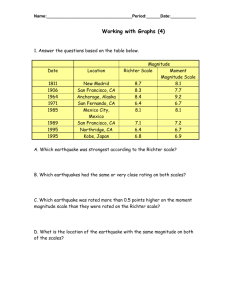OF ROCKS CHEMICAL CLASSIFICATION DATA PROCESSING OF 30
advertisement
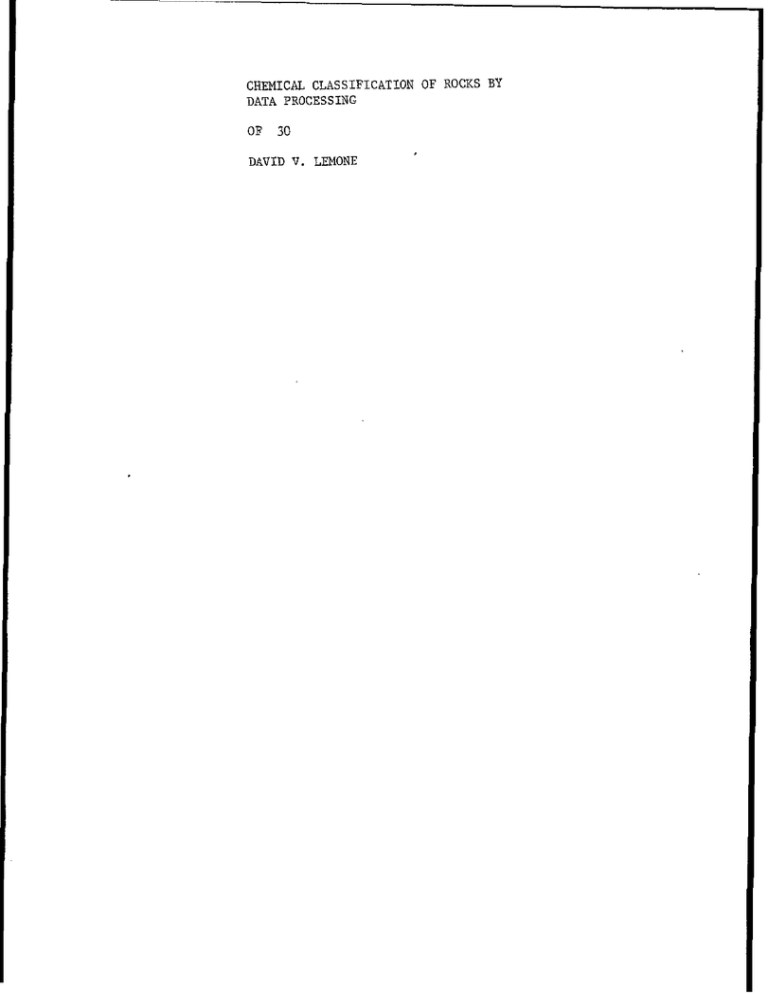
CHEMICAL CLASSIFICATION OF ROCKS BY DATA PROCESSING OF 30 DAVID V. LEMONE New Mejrico State Bureau of Mines and Mineral Resources I Open-file Report with 9 volumes of computer print-out sheets and 2 boxes of input cards L . . CHEMICAL CLASSIFICATION O F ROCKS BY DATA PROCESSING by David V. LeMone The University of T e x a s a t El P a s o . 2 CONTENTSOFREPORT Page , . .. 4 Abstract 5 &troduction 6 Definition of problem 7 Input 7 P r o g r a m Rock data . 12 P r o g r a m Rockplot 13 Conclusions 16 References . Figures 17 1 - Data input 18 2 - Program rockdata 19 3 - Program rockplot 20 4 - Plot of igneous rocks of Bohemia 21 5 - .Quartz latite analysis 22 6 - Detailed quartz latite ana1y.sis Table 23 24 3 :. .1 - Mobil Research oxide .!.;I ianalyses , I. . ' 2 - Comparison of Rockdata and Mobil calculations ' 27 - P r orgorcakmd a t a 40 4 - Program rockplot 1 3 CONTENTS OF SUPPORTING DATA ' Volume 1 Appendices Appendix 1 - P r o g r a m R o c k d a t a I1 2 It 3 4 5 6 7 - ProgramRockplot - New Mexicodata - Santa Rita data - Mobil t e s t d a t a - T e s t list igneous rocks - Classified rock list pages 13 pages 15 pages 20 p a g e s 4 pages 40 pages 81 p a g e s Numerically Indexed Artifical Johannsen Chssification . Volume I1 1100-1424 Volume 111 2100-2210 Volume IV (Classified alphabetically rock by name) 2207 Volume V 2211-2323 Volume VI 2400-4424 Numerically Indexed Differentiation Index (DIFWX) Volume VI1 0. 0-45. 0 Volume VI1 45. 0-70. 0 Volume IX 70.0-100.0 ABSTRACT Chemical Classification of Rocks by Data Processing Computer calculation and classification of m o r e t h a n 1800 oxide a n a l y s e s of igneous rocks has been completed to determine individual weight and volume percentages, color indices, differentiation indices, and artificial Johnannsen system classification notation. The two prog r a m s d e v e l o p e d f o r t h i s p r o b l e m a r e b a s e don d a t a f r o m the eleven standard oxides of whole-rock analyses. The programs are: R OCKDA T A C. I. P. W. calculation which determines weight percent tive minerals. Calculations for percent and type of n o r m a - of olivine and plagio- clase feldspar, color index, and differentiation index. Conversion of 1. to 1 0 0 percent. Conversion of 2. to volumetric percent by dividing b y the specific' gravity and adjustment of data to 100 percent. Recombination of the data of 3. and adaption to an artificial Johannsen classification. Steps 1-4 will result in a four page data printout. ROCKPLOT Printout of ROCKDATA is suppressed. Calculated diffecentiation and c.olor indices may be plotted against each other as well a s silica per- centage by m e a n s of a Calcomp plotter. This program utilizes data produced by ROCKDATA. P r o g r a m p r i n t s s u m m a r y of color index. differentiation index, and percent silica for each plot as a datacheck. 5 INTRODUCTION This study of the chemical classification of rocks has developed from the author's introduction to programming and Control Data Corporation 3100 computer during 1969. The p r o b l e m of chemical classifi- cation was chosen a s the result of the memory of his earlier difficulties in petrography a s an undergraduate. T h e r e i s nothing particularly new or unique about the presentation of t h i s material in the application of computers to chemical classification systems in petrography. Johnson (1962, p. 143-155) has developed flow charts and successfully tested them on a n I. B. M. 650 s y s t e m a t t h e University of Oklahoma Computer Laboratory nearly .ten years ago. The hardware,. software, and peripheral equipment 'is evolving and in a constant state of flux. This system, with some of its peculiar capabili- t i e s , i s present with the hope that it might prove to be useful to petrographers and mineral industry personnel working in this discipline. .Card decks of t h i s p r o g r a m a r e a v a i l a b l e on application from either the Director of the New Mexico State Bureau of Mines and Mineral Resources, Campus Station, Socorro, New Mexico,87801 of the Computation Center, University of Texas at El P a s o , El P a s o T e x a s , 79968. Specific inquiries may be directed to the author at Post I 0ffice.Box 3, University o r the Director . of T e x a s a t El P a s o , El Paso, Texas 79968. 6 The p r o g r a m h a s b e e n d e v e l o p e dat the University of T e x a s a t El PasoComputationCenter on a systemconsisting of: . . Control Data Corporation 1) 32K CDC 3100 2)415punch 3) 405 c a r d r e a d e r 4) 505 p r i n t e r 5 ) 604 tape drive ( 3 ) (only one required) 6) 854 disc storage (2) (only one r e q u i r e d ) Calcomp 1) 566 plotter The programs have been written in FORTRAN IV. This study was supported in part by the of Mines and Mineral Resources, University New Mexico State Bureau of T e x a s a t El P a s o R e s e a r c h Institute (Grant 083-50-79408) and the University of T e x a s a t El P a s o Computation Center (UGEO0002).The writer gratefully acknowledges DEFINITION O F PROBLEM * The objective'.is 'to develop a numerical classification scheme for '.. "'rd.2lc'kS.baii?E'b'ri t ~ ~ ' : ~ t L f i ~ ~ . r d ~ ~ i d e canalysis. c h e ~ i c rThis ll in a classical method utilizing the is to be done C. I. P. W. s y s t e m ( C r o s s , I d d i n g s , Pirsson, and Washington) and the Johannsen classificatirn scheme 0 vania State University I. B. M: program developed by Charles W Ondrick and John Holloway (1967) to the CDC s y s t e m i n 1969. A print out format system for the C. I. P. W. was developed next (Appendix 5 page .I). T h e r e s u l t s f r o m this d a t a a r e r e c a l c u l a t e d f r o m t h e first C. I. P. W. t o I00 p e r c e n t a n d r e s u l t i n t h eC.-I. P. W. i. FUDGE (Appendix 5', page 2). Several additiona1,determinationsa r e m a d e by t h e s y s t e m at this point; they are: 1) Determination of the precise normative plagioclase feldspar in t h e a l b i t e - - a n o r t h i t e i s o m o r p h o u s s e r i e s if plagioclase is present p r i n t s : A) p e r c e n t B ) m i n e r a l n a m e (6 i n t h e s e r i e s ) 2 ) Determination of the precise normative olivine in the forsteritefayalite isomorphous series if olivine is present prints: A ) p e r c e n t E)m i n e r a l n a m e (6 in t h e , s e r i e s ) 3 ) Determination and print statement for differentiation index or (DIFINX) a s developed by Thorton and Tuttle (1960). weight percent (normative C. I. P. W. ) s u m of: quartz orthoclase . ,lit . albite . . ~ nepheline leucite kaliophilite (kalsilite) I It is the 9 The rocks being studied can be numerically indexed by differentiation index as i l l u s t r a t e d by the partial classification study made of the rock types calculated here (see Volumes VII-IX) . 4) Determination of colorindex(COLINX) , i It is theweight .percent (normative C.I. P. W ) s u m of: hypersthene .. olivine magnetite ilmenite . apatite diopside This value could be used as DIFINX. f o r classification in the same manner The COLINX data should be derived from the volume percent calculation (Appendix 5,. page 3 ) . The f i r s t p a r t of the system has been tested. Data was supplied f r o mD r . R. Dennison of MobilReslearchLaboratories(Table nine undesignated igneous rocks that he had calculated. p a r t of ROCKDATA was then tested (Volume I, . The C. I. P. W. Appendix 5). . 1) f r o m - . A tabular comparison of the two calculations,shows two discrepancies (Table 2);. : i " " .. 10 The next step is the conversion to an artificial Johannsen system. This is accomplished by conversion of all weight percents to volume percents by dividing by specific gravity and then converting these results to 100 percent COLINX, DEFINX, olivine type, and plagioclase feldspar are also calculated (Appendix 5, page 2). The Johannsen system which is classified on t h e b a s i s of c l a s s , o r d e r and family is then printed out i n - s u m m a r y f o r m a s the last analysis -(P1. 4, fig. 4). The basi.s.of this artificial system Class (1-4) is a s follows: designation based on volume percent of l i g h t and dark minerals-- light minerals (leucocrates) Class 1 100-95 Class 2 95 -50 Class 3 50-5 Class 4 5-0 dark minerals melanocrates(?) (melocrates) in reverse order Order A ) ( 1 - 4 ) ( f i r s t t h r e e c l a s s e s ) d i v i d e d by albite-anorthite content of plagioclase feldspar. No plagioclase o r If albite ( 1 0 0 - 9 0 ) o r d e r 1 albite ( 9 0 - 5 0 ) o r d e r 2 albite ( 50-10) order 3 albite ( 1 0 - 0 ) o r d e r 4 Orders are split into 26 families (0-25) Based on a percentage split of 1) Quartz and felspathoids 2) Orthoclase to plagioclase felspar B) O r d e r s (1-4) Class 4 If percent of ore to melocrates (undefinable by standard references) GE. -95 class 4 95-50 class 3 50-5 class 2 5-0 class, 1 Families (0-12) (13 total) . FAMILY CENTER Olivine - . GE. 0 95% Olivine 95-50 1-4 Olivine 50-5 5-8 Olivine . LE. 5 9-12 ( P e r c e n t of olivine to percent of melocrates minus ore) Families are lumped in class 4 because it is not possible to split biotite, amphibole, and pyroxene. ROCKDATA t h e r e f o r e r e s u l t s i n a four-page printout (see Appendix 5, p. 1-4) c. I. P. w. 1) 2) C.I. P. W. t FUDGE (C. [. P . W. 3 ) Volumepercent 4) Artificial Johannsen system ' calculated to 100 percent) 12 Separation of the four printout sheets makes an excellent and easily accessible reference set. PROGRAM POCKPLOT (See appendix 2 and figures 3 , 4, 5 and 6 ) This program utilizes the data generated by programROCKDATA. Print statements have been suppressed as comment cards. A subprogram SUBPLOT.has added been ' . , . . . . . ,. system. to the r m ~ w i e x ' ein@nDqwablrennrufeikim&pE6& ~ 3 i l a p : o ; g r a m . o f this type&: dima~iewsn~~f;)rm,f& .. I ontheplotter.&.(PZeasEt.not&tcomment 5 on figure 3). plotter takes, the:parameters;listed hare, adds TheCalcomp . .. ,; ..:" .~*.,. . 5 inch, and then truncates.r;.r.. :;,.:..! . . Divisions on the X and Y a x i s a r e s p a c e d at one inch each, therefore, If, instead 9.5 or 9 . 8 w e r e the division w i l l b e l i s t e d as 11. 1 percent. utilized, the plot would be divided on a b a s i s of 1 0 p e r c e n t b e c a u s e a s the . 5 inch is added and then truncated to nearest whole number the r e s u l t would be 10. The detail .may be adjusted by changing the values of 0 and Q in f i g u r e 3 (See figures 5 and 6). Program ROCKPLOT which utilizes disk storageis r u n o n f o r e ground. and the plot is run on background. By manipulating the program o n e c a n e a s i l y c o n v e r t f r o m t h e p r o g r a m.mode of differentiation index VS. weight percent silica'to color index vs. differentiation index or color index vs. weight percent silica. The program also prints out the .. data (COLINX, DIFINX, SI0 2 ) on each plot as well as its alphanumeric notation. The end result of ROCKPLOT is a two-dimensional scatter diagram displaying any two v a r i a b l e s ( f i g u r e s 4, 5 and 6). It is then possible to divide rock types into easily discernible fields which may reflect diff e r e n c e s in genesis and alteration. CONCLUSIONS The utilization of : t h i s p r o g r a m is in its speed of calculation, ROCKDATA print out, ana its easily readable ROCKPLOT charts. .A .~ :I t r ' are: number .of. a p p l ~ ~ ~ a t i o n ~ ' ~ n ~ b ~ . ~a secaesr t~a ianne da b frozpcLi$&s~ l~ ,r,eq$$~LoL.Iu,xU., IlhtG'PF,;d 4G.a . a i l r : i . I : ,,i 11 i 4 t i , : ; - < , : , ,,t,ioI.';d 2 ~ , , 2 , they . .. .~ = . :. . . . . \ . ,., . 1) Genesis of r o c k s . . _ . , . .l . , I- . <.:Igh.eous.-rocks of sim$la.r;designaiion,maybe visually .sepa,r,$&bby,_L:.5 Ll 14 ROCKPLOT into broad fields (e. g. oceanic and plateau basalts). Recognition of o r e d e p o s i t s a n d a l t e r a t i o n e f f e c k The origin of an ore deposit because of its peculiar chemical environment and accompanying alteration effects must by its v e r y n a t u r e effect the host rock. Therefore, in a given plot of an igneous rock type ore deposits and altered rocks should plot outside the normal graphic position. Metasedimentary and metaigneous rocks The chemical composition of these rocks differ significantly from each other and from igneous -rocks that they may resemble. These types separate out nicely in the artificial Johannsen system and less clearly on the plots (see Volume 11-VI). Literature search Rock data that coincides in position on plots, despite being widely separated geographically, may indicate similar environments of formation (e. g. a basalt from Siberia and from New Mexico). It i s possible that no comparison really exists; however, it enables a rapid check of r e f e r e n c e s which l i s t e d with the ROCKPLOT. Classification of aphaniticigneousrocks .. Preliminary examination of the results of chem.ical classification indicate. that (the system should be. very useful .in t h i s a r e a . P e t r o - . .. graphically determined latite has a great variability in composition I O 1 1 ...~ .. .. . ‘ I . . . I rangi’ng f r o m essentially alrkiyolite to virtually a basalt as an example. .. 15 6) Other P a r a m e t e r s The program may be revised to include the calculations for such i t e m s as crystallization index (Poldervaart and Parker, 1964) and solidification index (Kuno, 1968) which then can be plotted for visualexamination,Theproduceddata,withconversion,could be statistically tested for factor analysis, etc. Despite the rapidity and ease in which the calculations for the chemical classification designates &an be made and the visual determination from plots that can be utilized in this type of system, it cannot replace the hand specimen and thin-’section analysis made b y t h e p e t r o grapher. It should also always be remembered that the computer can neither judge the quality of a chemical analyst nor the accuracy of the data it manipulates. The data produced by this system should, hopefully, b e a meaningful adjunct to the worker. ., . I .:.. REFERENCES Johannsen, Albert, 1931, A descriptive petrography of the igneous rocks, Univ. C h i c a g o P r e s s , v. I, Introduction,textures,classifications and glossary: 319p. Johnson, Kenneth S., 1962, C P W flow chart: Oklahoma Geology Notes, v. 22, p. 143-155. Kuno, Hisashi, 1968, Differentiation of basalt magmas, _in Basalts, Hess, H.H: , and Poldervaart, A., eds., John Wiley and Sons I n t e r s c i e n c e P u b l i s h e r s , New York,p.624-688. Ondrick, Charles W. and Holloway, John, 1967, CLPW n o r m f o r I. B. M. : Penn. State Univ., Mineral Industries Exp. Sta., Contribution in Computer Science, 67 s e r . P o l d e r v a a r t , A. and Parker, Alfred B., March 1964, Crystallization index and normative analysis: Amer. Jour. Science, v. 262, p.281-289. ,Thornton, C. P. and Tuttle, 0 F., 1960, Chemistry of igneous rocks, I. Differentiationindex:AmeriJour.Science, v. 258,p.6646 84. r r D m m r m D z D v) 2- y w - .Y TIC' CODE Y '> A - g JOB CARD B -9’ FORTRAN, L,X C-PROGRAM ROCK DATA D-FINIS (COL.10) E -9’ LOAD,56 F-$RUN,IO,NM G-DATA DECK (SEE PLATE I ) H -999 EF I - B L A N K CAR,D J - g i (END OF JOB) /J I - H - E D - - 60 A P r o g r a m Rockdata.. A.-97 JOB CARD B CT0,USING PLOTTER C - 4 DlSK,(49,64,500) (10,64,500) D -4 FORTRAN,L,X E -PROGRAM ROCK PLOT AND SUBROUTINE SUBPLOT F -FINIS (COL.IO) LOAD,56 /v G H - 4 RUN,5 /U I -DATA DECK (PSLEAET E I) T / J -999EF /S K - B L A N K CARD R L -BLANK /Q M - 2 (2) P N - I-: 4-2 ( 3 ) ' /o -: -a CARD - - ~ - - - N 2 I /H /G (F . .. E (D /A /C (B - - P-9.0 9.0 ( 5 ) Q - 01.00 7100.0 (6) 20 R-LIMBURGlTE(7) S - T I T A N AUGITE (8) T-DIFFERENTIATION I N D E X U-WEIGHTPERCENTSlLlCA(l0) V-gz (END OF JOB) 5 0 z - I .' . + 10.w 3151 * + + * I + 20.00 + + UGE00002 + + : I 30.00 + + + + + + + + ++ + + + +++ + + 40.00 50 .OO DIFFERENTIRTION INOEX .. ... 60 .OO 10.00 + 00.03 I + + + I 90.w I 100.00 . + ++ + + + + + + + + + * + * + -+ + I +# + + . + ' + c + + + . + + + + +* + + + + . + ++ I ... Table 1 - - Mobil R'esearch' Oxide Analyses (courtesy R. Dennison f o r s y s t e m t e s t ) 3 xx 4xx Si02 1xx 54.77% 61.61% Ti02 1.02 A12 3 ' Fe 0 2 3 FeO , 14xx 57.75% 5xx 56.45% 6XX 52.23% 7xx 61.03% 11XX 52. 89% 13XX 67.66% 58.90% 0.57 0.95 0. 61 0. 65 0. 90 1. 32 0.48 0. 88 17.,71 19.37 18.99 20.43 23. 37 17.03 18.46 16.45 17.07 4. 80 1.12 2.10 2. 70 0. 90 4.57 4. 27 1. 80 1.95 . ,3.64 0. 88 1.89 1.35 1.69 3. 17 1. 08 3.24 MnO . 0.21 0. 09 0.16 0.21 0. 24 0. 1 6 0. I 9 0. 08 "0 2. 40 0. 65 2.12 0.44 1. 40 1.20 3.23 0. 28 0. 15 Ca 0 8:11 5. 63 9. 26 4.90 7. 42 5. 82 9.08 3. 34 5.29 Na2 0 4.00 4. .61 5.10 6.25 4.61 4. 23 4.43 4.50 4.79 K2 O 1. 92 4.79 1. 56 4.03 2.65 4.57 2.77 4.15 3.00 0. 0 6 0.00 0. 08 0. 0,o 0.03 0.05 0.01 0.00 0.01 0.00 0.00 0.00 0.00 0.00 0.00 0.00 0.00 0-00 0. 30 0.13 0.00 0. 28 0.00 0.00 0.00 0. 10 0.22 1 . 15 0.60 0.39 2. 02 1.45 0.55 0.33 0.31 2.62 H20- 0.21 0.00 0. 18 0. 27 Total LOO. 30 100.05 IOO. 03 0.37 - p2 5' s03 c02 H20t 100.04 ' 2.56 99. 70 . ' ' 0 . 09 100.17 100.24 0.03 - 100. 26 2.03. 0.05 100.20 , TABLE 2 -- Comparison of ROCKDATA and Mobil Calculations ROCKDATA Mobil Sample 1XX Apatite Ilmenite Orthoclase Albite Anorthite Magnetite Quartz Total Diopside .. with the composition Diopside (WO) Diopside (EN) Diopside (FS) Total Hypersthene with the composition Enstatite .Ferrosillite "_ . 139 1.937 11.347 33.847 24.700 6.960 5.988 12.055 I. 94 11.34 33.83 24.10 , 6. 96 6. 00 12.06 6.324 4. 627 1. 103 i. 672 1.350 .322 Sample 3XX Ilmenite Orthoclase Albite Anorthite Magnetite Hematite Quartz Total Diopside Wollastonite 1. 083 28.308 39. 009 18. 015 1 . 478 .lo1 5.569 3.491 2.268 Sample 4XX Apatite Ilmenite Orthoclase Albite Anorthite Magnetite Quartz Total Diopside Wollastonite 185 1. 804 9.219 43.155 24.318 3. 045 3.680 12.261 2.295 . Calculation 1.66 ' 1. 08 28. 3 28.30 18.02 1. 48 .10 5. 6 3.49 2.26 "_ 1.80 9.22 43. 13 24.32 3. 05 3.7 12.26 2.31 (Table 2, continued) Sample 5XX Ilinenite Orthoclase Nepheline Albite Anorthite Magnetite Hematite Total Diopside Wollastonite 1.159 23.816 5.492 42.748 15.791 3.268 .446 2.363 2.289 Sample 6XX Apatite Ilmenite Orthoclase Nelpheline Albite Anorthite Magnetite Total Clivine Total Diopside .070 1.235 27.008 10.563 19.511 29.580 1.305 2.900 5.814 ~' Sample 7XX Apatite Ilmenite Orthoclase Albite Anorthite Magnetite Hematite Quartz Total Diopside Wollastonite Acmite Sample 11XX Apatite Ilmenite Orthoclase Nepheline Albite Anorthite Magnetite Total Olivine Total Diopside ' . 116 1.709 15.661 35.794 19.656 3.360 2.252 14.082 6.446 .256 0 . 023 1. 16 23.81 5.35 42.98 15.80 3.27 .45 2.36 2.28 "_ 1.23 27.00 10.54 19.54 29.59 1. 31 2. 90 5. 82 "I. 7 1 15.66 21.41 "- "_. 2 8 20.84 9.75 6.93 12.66 "_ 2. 507 16.370 3.517 30.993 22.306 2. 51 16.37 3.49 3 1.03 22.31 6.191 6. 19 .16 .154 17.761 17.75 260 (Table 2, continued) Sample 13XX Ilmenite Orthoclase Albite Anorthite Magnetite Hematite Quartz Total Diopside Wollastonite Sample 14XX Apatite Ilmenite Orthoclase Albite Anorthite Magnetite Quartz Total Diopside Hypersthene Total .912 24.526 38.078 12.431 2. 351 .I79 18.920 1.504 .922 . 023 1.671 17.729 40.532 16.218 2.827 5.932 8.119 .91 25.52 38. 06 12.44 2.35 .I8 18.94 1. 50 .92 "- 1. 67 17.72 40.5 1 16.22 2. 83 5.96 8. 11 C C C C C C C C C C C C C C C C- C C C C c C C C C C C C c C I:. c I: L a h' m h 4 r m -. " :.. .. .. ;z .. I.' 3 . T T. T' r: KP . 9 245 . S?Ai? (Table 3, continued) 339 (Table 3, continued) 1 1 1 ?1 I 70 .. i ROCKPLOTEXPLANATION 2. 2 = number of p l o t s 3. 2 and 4 = number of-points for each p l o t i n order ( f i e l d of three). 4. X axis percentage range (0.0-100.0). 5. 9.0 and 9.0 a r e dimensions on plotter paper of graph. 6. Y axispercentage 7. Title card plot1. 8. T i t l e card p l o t 2. 9. Axis t i t l e 10. Axis t i t l e . - ... range (0.0-100.00). C C C C C C C C C C C ? c:. c: L C' c . C C C' c: c c. , C C C - c,-. C C C C C C C C C c . C C c C c C C - . -. 8~ '12; ,, C C C C , c C i^ C C C I ,. .-. I . , i- $ i' - -i!. I I (Table 4, continued) Xw=n, [I t 1 E ' I '04XLC I '\IDEX .. " -1 .. . .. . .. 4. . . 'L c : . c + c . . . ..+-I+ : < + < :j+ + a C C .. .... t pr P P P P P P P P P P P P . . .. ' ,,, I . . P . . , . ; I ' .. r I P. P ?: P. .P. P P. . pi r i PI Pi PI P! PI P! FI ri P! P! P! Pt P( PL PI Pi P! PI , ,I I I .5 .: (Table 4, continued) !RAY 53 F F 1330 1'240 1 1 1090 1 4 1'1'80 37 365' 320' 2751 35 .. , ... . ,, 1 - " _. L " t .. . , A ...
